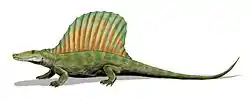| Glaucosaurus Temporal range: Early Permian, | |
|---|---|
 | |
| Holotype skull at the Field Museum of Natural History | |
| Scientific classification | |
| Kingdom: | |
| Phylum: | |
| Class: | |
| Family: | |
| Genus: | †Glaucosaurus |
| Type species | |
| †Glaucosaurus megalops [1] Williston, 1915 | |
Glaucosaurus is an extinct genus of small edaphosaurids from the Early Permian. The type species, G. megalops, was named in 1915.[1][2]
Classification
Glaucosaurus is known only from its holotype, a partial skull and jaw. Almost all of the sutures have been obliterated. Nevertheless, there is broad agreement that Glaucosaurus is not only an edaphosaurid, but a close relative of Edaphosaurus itself.[3]
All of the known sphenacodonts are carnivores except for certain therapsids. Glaucosaurus is plainly not a therapsid, e.g. because the lacrimal reaches the naris, the septomaxilla is large, there are no incisors, etc. And it is just as plainly not a carnivore, since it lacks cutting edges on the teeth or canine-like teeth. So, it is very likely to be an edaphosaur. Assuming that this is the case, it is very close to Edaphosaurus, because only Glaucosaurus and Edaphosaurus completely lack both canine teeth and a canine buttress, lack the transverse flange of the pterygoid, and have prefrontal with a ventral (descending) process which is expanded toward the middle of the skull, forming an anterior housing for the eyeball. However, Glaucosaurus differs from any of the known sorts of Edaphosaurus in have an incredibly long maxilla, and in the equally extreme length of the prefrontal's ventral process.[3]
See also
References
- 1 2 "†EDAPHOSAURIDAE – edaphosaurs". Mikko's Phylogeny Archive. Retrieved 21 May 2015.
- ↑ S. W. Williston. 1915. New genera of Permian reptiles. The American Journal of Science, series 4 39(233):575-579
- 1 2 "Glaucosaurus". Palaeos. Retrieved 21 May 2015.
External links





.jpg.webp)